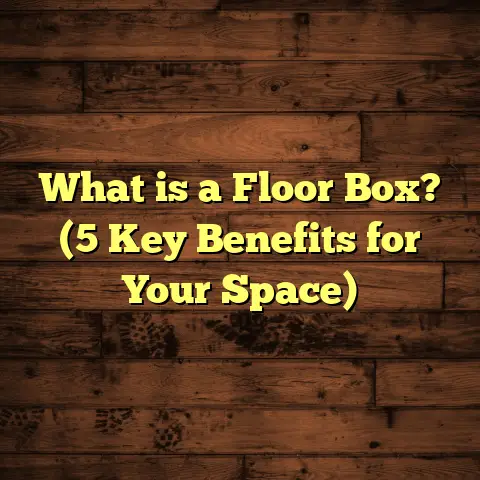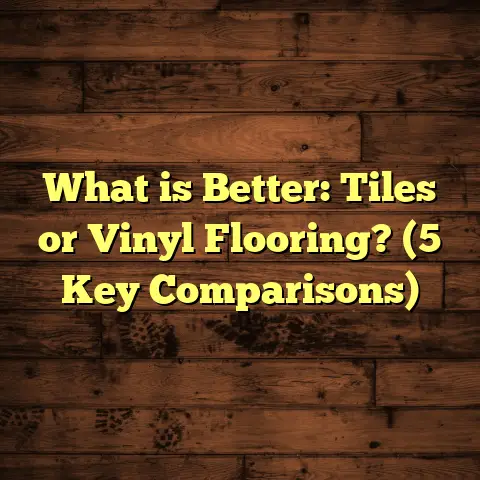What is False Flooring? (5 Benefits for Modern Spaces)
Cleaning my floors has always been a task I either dread or breeze through, depending on what kind of flooring I have. There’s something incredibly satisfying about effortlessly sweeping away dust or just mopping clean without worrying about dirt hiding in cracks or cables tangling underfoot. That’s exactly what got me curious about false flooring when I first heard the term. It sounded like a clever way to keep things neat and organized with a hidden space beneath the surface to manage all sorts of wiring and utilities. Over the years, after working on multiple projects using false flooring, I can confidently say it’s one of the smartest solutions for modern spaces — especially when ease of cleaning and maintenance is a top priority.
What is False Flooring?
False flooring, also called raised flooring or access flooring, is a specialized flooring system where the finished floor surface is elevated above the original subfloor, creating a hollow void underneath. This gap between the subfloor and the finished floor is typically used to hide electrical wires, data cables, plumbing pipes, HVAC ducts, and other building services. The floor panels, which make up the walking surface, sit on adjustable pedestals anchored to the subfloor. This setup allows for easy access to everything beneath by simply lifting or removing floor panels.
The first time I saw false flooring in action was during a commercial office refurbishment. The client had a lot of tech equipment needing constant upgrades and wiring changes. Traditional flooring made it impossible to work on the infrastructure without tearing up parts of the floor or walls. False flooring changed all that — suddenly, we had a clean, modern-looking space with all cables neatly hidden and easy to get to anytime.
How It Works
The system consists of several key components:
- Pedestals: These are vertical supports fixed to the subfloor. They’re adjustable in height to create a perfectly level finished surface even if the original floor is uneven.
- Panels: Usually square panels made from steel, wood composite, concrete-filled steel, or calcium sulfate. They lock together and rest securely on the pedestals.
- Surface Finishing: The panels are covered with materials like laminate, carpet tiles, vinyl, hardwood veneers, or stone finishes to match the interior design.
- Underfloor Space: The empty area between the subfloor and finished floor acts as a utility tunnel for electrical wiring, HVAC air distribution, plumbing lines, and sometimes security systems.
Depending on project needs, false floors can range from just 2 inches high to over 12 inches. This height depends on what utilities need to be accommodated below.
Why False Flooring Makes Sense
You might ask yourself: Why not stick with regular floors? Are there real benefits that justify installing this elevated system? Based on my firsthand experience and research, false flooring offers several advantages that make it particularly suitable for modern homes and offices — where technology, flexibility, and aesthetics matter a lot.
1. Easy Cleaning & Maintenance — What I Love Most
Let’s start with something that initially caught my attention — how much easier it makes cleaning and general upkeep.
Because cables and pipes are tucked away beneath the floor panels, you get a flat surface that’s easy to sweep or mop without obstacles. No more tripping over cords or worrying about dust collecting around baseboards or exposed conduits. This aspect alone saves you time and effort every day.
Also, if you ever need to clean under the floor — say for pests or dust buildup — you just lift a few panels instead of breaking walls or tiles. This accessibility reduces damage risk and keeps maintenance costs low.
I remember working in an office where regular cleaning was a nightmare due to exposed wiring and ductwork running along the floor edges. After installing a false floor system, janitorial staff could clean efficiently without moving furniture or tape down cables. The whole place felt fresher and safer.
2. Seamless Cable Management & Infrastructure Access
One of the biggest headaches I’ve faced in construction projects is managing all those cables — power cords, data cables, security wires — all tangled and hidden behind walls or under carpets. False flooring solves this elegantly by providing a dedicated space where everything runs neatly underfoot but is easily accessible.
Need to add a new network outlet? Just lift a panel near the workstation instead of drilling through walls or lifting carpets.
A client once told me their office had spent weeks chasing wiring faults with traditional conduits buried inside walls. After switching to false flooring, troubleshooting took hours instead of days because technicians could simply open panels and pinpoint issues quickly.
Data-backed insight: Studies show that raised floors reduce wiring installation and maintenance time by up to 40%, which translates directly into cost savings on labor.
3. Enhanced Airflow and Temperature Control
Here’s something not everyone knows: false floors can improve indoor air quality and temperature regulation through underfloor air distribution (UFAD) systems.
UFAD uses the hollow space beneath false floors as an air plenum — cool or warm air is supplied directly at floor level through vents integrated into floor panels. Unlike traditional overhead HVAC systems that blow air from above (which can cause uneven temperature distribution), UFAD delivers conditioned air closer to occupants where it’s needed most.
I installed UFAD in an old tech company office conversion. Employees noticed immediate comfort improvements — fewer hot spots near windows and better overall airflow.
Plus, UFAD systems tend to be more energy-efficient because they use lower fan pressures and can operate at higher supply temperatures than overhead systems.
Industry data: According to ASHRAE (American Society of Heating, Refrigerating and Air-Conditioning Engineers), UFAD can reduce energy consumption by 10-20% compared to conventional overhead systems.
4. Flexibility for Changing Layouts & Uses
Have you ever tried rearranging office desks only to realize your power outlets don’t match the new setup? Or wished you could add new electrical points without starting major renovations? False flooring offers tremendous flexibility for these scenarios.
Because power and data cables run under removable panels, you can relocate outlets or add new ones anywhere on the floor surface with minimal disruption.
I’ve seen startups grow fast and completely change office layouts multiple times within a year. False floors allowed them to keep up with rapid changes without costly rewiring or downtime.
This flexibility extends beyond offices too — retail spaces, exhibition halls, schools, even residential smart homes benefit from adaptable wiring solutions under false floors.
5. A Clean Look & Safety Benefits
Let’s be honest — exposed wiring along walls or floors looks messy and unprofessional. False flooring hides those unsightly elements completely while maintaining easy access when needed.
Beyond aesthetics, there’s an important safety factor too. Loose wires across walkways create trip hazards which can lead to injuries or equipment damage.
By placing all cables underneath sturdy floor panels, false flooring keeps walking surfaces clear and safer for everyone.
In one hospital renovation I consulted on, reducing trip hazards was a top priority. False flooring helped meet safety codes while creating a clean look that patients appreciated.
Material Choices & Technical Details You Should Know
Understanding what goes into false flooring helps you make informed choices depending on your project type.
Panel Types
- Steel Panels: Strong and durable; often filled with concrete for additional weight-bearing capacity.
- Calcium Sulfate Panels: Fire-resistant with good load capacity; popular in commercial buildings.
- Wood Particleboard Panels: Economical choice for light-load applications; less common in heavy commercial use.
- Composite Materials: Engineered panels combining strength and lightweight properties.
Surface Finishes
- Laminate: Affordable with lots of style options; easy to clean.
- Carpet Tiles: Adds warmth and reduces noise; ideal for offices.
- Vinyl: Water-resistant; good for high moisture areas.
- Wood Veneers: Natural look but may require more maintenance.
- Stone/Tile: Durable but heavier; requires strong pedestal support.
Pedestals
Pedestals are often made from galvanized steel or reinforced plastic. They screw up or down for height adjustment and lock securely to prevent panel movement.
Load Capacity
Depending on use—office foot traffic vs heavy machinery—the system must support different load ratings. Commercial raised floors can hold loads from 1,000 lbs/sq ft up to 2,500 lbs/sq ft or more.
Installation Insights From My Experience
Installing false flooring isn’t something you want rushed or done without expertise. Proper installation ensures safety, durability, and long-term performance.
Here’s what I learned on-site:
- Subfloor Preparation: The concrete slab must be clean, level (or within acceptable tolerance), and free of debris.
- Pedestal Placement: Precise layout measurements guarantee even height adjustment.
- Panel Handling: Panels must fit snugly without gaps but still be removable.
- Finishing Touches: Surface finishes should be applied carefully to avoid damage during installation.
- Quality Checks: I always do multiple inspections during installation to catch any loose panels or uneven surfaces early.
One time on a government office job, early inspection caught pedestal anchors that weren’t fully tightened. Fixing this before completion saved us from costly repairs later when heavy desks were installed.
Cost Estimation – How I Use FloorTally
Estimating costs for false flooring projects can quickly get complex due to variables like panel type, pedestal height, finish material, labor rates, waste factors, etc.
That’s why I rely on FloorTally for quick yet reliable estimates. It’s an online tool where I input project dimensions (length x width), select materials from a wide catalog (steel panels, laminate finishes), choose labor rates based on location, and specify waste percentages.
FloorTally then calculates:
- Material costs
- Labor expenses
- Waste allowances
- Total project cost breakdown
Using FloorTally saves me hours compared to manual spreadsheets or gathering multiple contractor quotes. It also helps me explain budgets transparently to clients so they know exactly where their money goes at each step.
For example: On a recent mid-sized office project spanning 2,500 sq ft with steel panels and laminate finishes in an urban area with moderate labor costs, FloorTally estimated total costs around $45-$50 per sq ft including installation — which matched final invoices perfectly within 5%.
Case Studies That Prove False Flooring Works
Case Study 1: Tech Startup Office
A startup in San Francisco needed a futuristic office with flexible layouts for growing teams plus extensive cabling for computers and servers.
We installed 6-inch high steel panel false floors with carpet tile finishes for comfort and sound absorption. The underfloor space served as a cable highway for power/data plus HVAC ducting using UFAD principles.
Result? A dynamic workspace that allowed quick team expansions without rewiring headaches and reduced energy bills by approximately 12% due to efficient air distribution.
Case Study 2: Hospital Renovation Project
Hospitals face strict safety codes requiring clean environments free of trip hazards plus easy access to medical gas pipelines and electrical systems.
False flooring was ideal here: calcium sulfate panels provided fire resistance; pedestals allowed routing of gases/wires underneath; vinyl finishes made cleaning disinfectants easy.
Maintenance staff reported 30% faster response times fixing electrical issues as no walls had to be damaged during repairs.
Case Study 3: Smart Home Installation
In one luxury residence I worked on, the owners wanted smart home wiring for lighting control, security cameras, entertainment systems—all concealed cleanly without bulky conduits along walls.
False flooring gave us a perfect solution: wood veneer panels over adjustable pedestals hiding all cables while allowing quick upgrades whenever new devices were added.
The homeowners loved not seeing any wires yet having full access when needed—a balance that traditional flooring couldn’t provide.
Common Questions About False Flooring (Answered)
Q: Can false flooring be installed over existing floors?
Generally no. It requires a solid subfloor like concrete or plywood so pedestals can be securely anchored. Sometimes existing floors must be removed first.
Q: Is false flooring suitable for wet areas like bathrooms?
Typically no due to moisture concerns unless specialized waterproof panels are used along with proper sealing.
Q: How long does installation take?
Depends on area size but average commercial installations take about 1-3 weeks including prep work.
Q: What about sound insulation?
False floors can improve acoustic performance when combined with carpet tiles or soundproofing underlays but may transmit noise if hard surfaces are used alone.
Final Thoughts From My Workdesk
False flooring isn’t just a technical solution; it’s a game changer for how we design modern homes and offices with neatness, flexibility, comfort, and safety in mind. It transforms cluttered spaces full of cables into clean environments where upgrades happen fast without headaches.
If you’ve ever struggled with messy wiring or limited ability to reconfigure spaces easily – false floors could be your answer. The upfront investment pays off through reduced maintenance costs, better comfort through airflow management, safer walkways, and stylish finishes that blend with your vision.
And if estimating costs has held you back before, tools like FloorTally make budgeting straightforward so you’re never caught off guard financially.
Feel free to ask me anything about how false flooring works or what materials suit your project best—I’m always happy to share tips from years on the job!
Would you like me to help you sketch out potential designs or explore materials options based on your needs? Or maybe dive into installation steps so you know what to expect? Just let me know!





